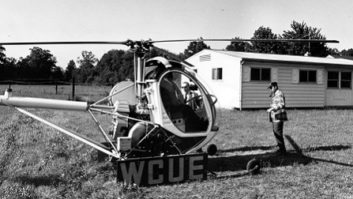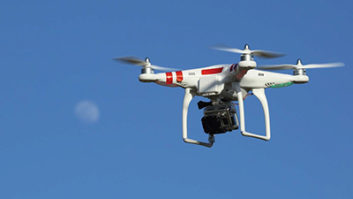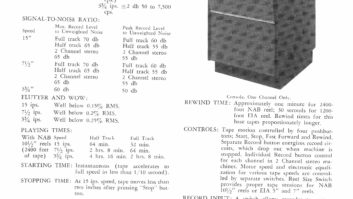You may soon see drones inspecting towers and carrying out other functions for radio stations.
TV news applications tend to get the headlines within the industry; but radio managers, too, are contemplating ways to use the unmanned aerial vehicles for technical and programming applications.

Barry Thomas, director of engineering for Wilks Broadcast Group, with his DJI Phantom 1 drone. Broadcasters are anxious to use drones for simple tasks like newsgathering and tower inspections, industry experts say; and some observers think these flying machines could one day perform more complex operations.
Drones are referred to by the Federal Aviation Administration as unmanned aircraft systems, or UAS. They are controlled by a pilot on the ground, or the device may be pre-programmed to follow a certain flight plan.
The commercial use of these airborne assets, which are regulated by the FAA, requires a special use permit. The FAA also requires operators of commercial drones to attend a drone flight training class approved by the government agency.
Currently drones must stay within site of the operator and weigh less than 55 pounds. Operations are limited to a height of 500 feet. The FAA may soon relax its restrictions on the commercial use of drones to allow them to fly outside of the operator’s line of site, according to media reports.
The FAA earlier this year announced several tests cases that could expand drone use, as Radio World reported. CNN, for example, is being allowed to test drones for newsgathering in populated areas; freight railroad company Burlington Northern Santa Fe will be allowed to fly drones outside an operator’s direct line of vision in order to inspect railroad tracks.
As the technology advances and regulations are relaxed, the difficulty of a drone’s assigned task could increase.
“Tower inspections are certainly one area where drones with video would be invaluable,” said Stu Graham, president of broadcast technical consulting firm Graham Brock Inc. “We now, too often, stand back 300–400 feet away from an antenna and say, ‘Looks good to me,’ and settle for that.”
He knows of no clients using one, but he perceives applications. “I can see where the use of a drone to document a tower and/or ground system installation from above — property boundaries, land clearing, FM antenna condition and beacon integrity — could be very valuable.”
ANTENNA REPAIRS
Another broadcast engineering consultant speculated that drones could one day be used as an aid for broadcast antenna repairs.
“Depending on what payloads are allowed, the lifting of objects could be a real bonus in tower maintenance,” this source said.
Another potential application is using drones for airborne antenna pattern measurement, said one consultant, although the requirement to keep UAS within sight of the pilot could limit its potential, given that broadcast signal measurements usually need to cover a wider area.
Tom Silliman, president of antenna and tower provider Electronics Research Inc., spoke about drones at a National Association of Tower Erectors conference earlier this year. He said the use of UAS in the tower industry has exploded; he intends to buy one and “get the required training to use it next winter.”
Silliman expects to see additional broadcast tower industry applications. “Look at the space that was used for drones at NAB in April. And a group exhibited at the NATE show this year. It’s going to expand and grow.”
One of Silliman’s goals is to equip a drone with an infrared camera to look for hot spots in transmission lines.
“You could also use a drone to verify that the tower lights are working correctly. With the new narrow-beam LED lights, you can’t tell if the lights are working correctly unless you move away from the tower.”
Silliman doesn’t anticipate using drones for signal strength measurements anytime soon, because of the difficulty in equipping a small craft with an antenna and signal strength meter, “but in time, it could happen.”
Drones will not replace qualified tower climbers, he said, “but they will be used more and more to identify the need to send men or women up the towers for maintenance.”
Dave Stewart, owner of Moving Target Consulting Works and former vice president of engineering for Hispanic Broadcasting System, sees applications.
“We can use them to supervise tower crews, or to see whether tower paint goes all the way around each leg or brace.” Drones can also “look for loose cables, missing or damaged clamps and rust spots.”
Marty Hadfield, director of engineering at iHeartMedia’s Seattle cluster, said early observation of damage to transmission lines, antennas and other tower-mounted equipment would help reduce downtime and repair costs.
He said that if the FAA develops new UAS operating guidelines for commercial and or news-gathering purposes that are less restrictive than current regulations, there would be nearly immediate use of drones by broadcasters and technical service providers.
“The possibility of short-range two-way radio or video repeaters carried aloft would provide source or relay opportunities for communications and ENG coverage of emergency or disaster conditions, where a land-based access could be prohibited by local conditions,” Hadfield said.
PROFICIENCY CONCERNS
Despite excitement, it appears most broadcasters are moving cautiously when considering implementation.
Barry Thomas, director of engineering for Wilks Broadcast Group, said the company hasn’t yet evaluated drones for technical purposes. “However, I’ve been discussing using drone-based cameras to cover station events for richer online and interactive listener experiences.”
Thomas owns a DJI Phantom 1 drone with a ReplayTV camera for personal use; he agrees with others that rooftop and tower inspections are among potential applications.
“However, even with an incredibly easy-to-fly drone like the Phantom, it would take practice and skill to have enough proficiency to fly a camera platform. Particularly at tower sites where you have unusual obstacles … including overhead power lines and guy wires,” Thomas said. “You have to know innately how to control the craft in tight spaces with very subtle moves.”
Emmis Communications has had preliminary discussions about using drone-mounted cameras for routine and emergency tower inspections to determine the urgency of repairs, said Sam Caputa, director of radio engineering for Emmis’ St. Louis cluster. In addition, drone-mounted infrared cameras could be used to identify hot spots on tower- and tall building-mounted RF and electrical systems to detect areas of potential failure, according to Caputa.
“Drone-mounted test equipment and communication receivers can also be used to take elevated measurements to analyze signal coverage patterns or to assist in resolving aircraft communications issues,” he said.
Cox Media Group is not exploring using drones for radio at this time, according to Vice President of Technical Operations Dave Siegler, though it is looking at drones for its television operations. “We really see the benefits of drones as tools in news gathering for TV, and not so much for engineering work,” he said.
Paul Shulins, director of technical operations for Greater Media Boston, said broadcasters must consider safety issues before using a drone near their facilities.
“The operating environment has to be considered. If the area has high RF levels, which is usually the case at a broadcast site, testing should be done to make sure the high RF fields of the licensed broadcast facility do not interfere with the operation of the drone, and that positive control can be maintained for the benefit of the safety of those on the ground, and the protection of the property within the range of the drone.”
Shulins owns two drones for personal use; he said even though today’s drones are reliable and sophisticated, another consideration for radio owners is liability.
“Make sure the person piloting the drone is properly qualified and uses good, common sense. That is critical.”
Are you using drones? Tell us how. Email[email protected]with Letter to the Editor in the subject field.












